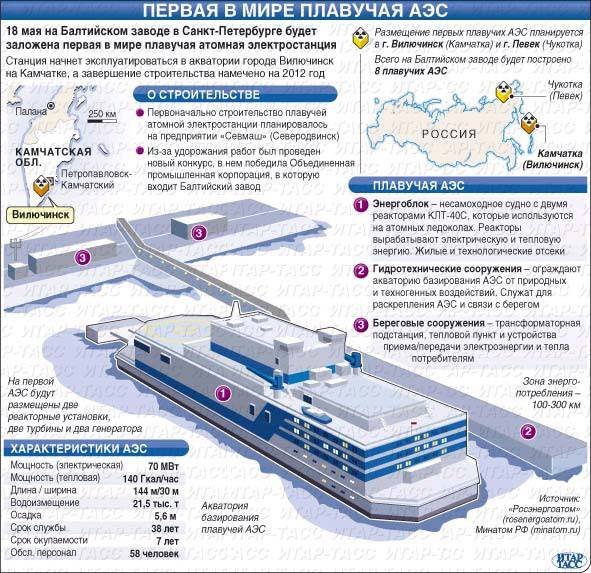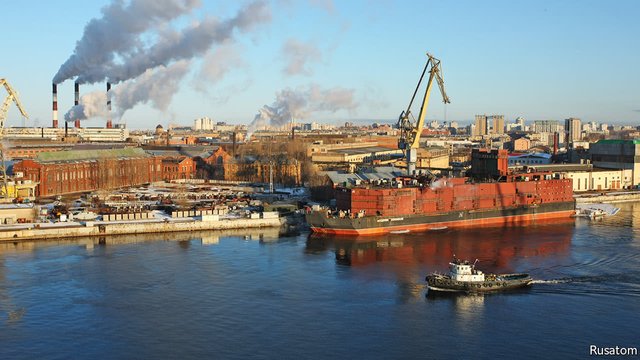Russia's Floating Nuclear Power Plant Is a Harbinger of a Revolution
A power plant of this kind has so many potential uses it's certain the first of its kind will be far from its last
by Anatoly Karlin
The world’s first floating nuclear power plant (FNPP) has just been launched from the Baltiysky Zavod in Saint-Petersburg. It will be towed for fueling in Murmansk, and then go on to provide power to the Arctic town of Bilibino in the Russian Far East, where the local NPP is due for decommissioning in 2019.
Autistic screeching from atomophobes regardless, there’s plenty of reasons why this is a very competitive idea.
- It’s surprisingly cheap: The Akademik Lomonosov, the first FNPP of its kind, costs only $250 million, and it should get even cheaper. Development costs are low – ultimately, it’s just a primitive barge with a reactor mounted on it, of the sort that are already used by Rosatom’s nuclear icebreaker fleet, as well as storage compartments for new and used fuel. Rosatom is one of Russia’s more efficient state-owned behemoths, so I don’t see all the money disappearing down a rathole (as would be the case if say Sechin was in charge).

- Not only can it to what any normal NPP can – the Akademik Lomonosov can provide 70MW of electricity and 300MW of heat, and these figures can be increased with bigger reactors – but it is also a mobile source of power. Potentially, it can provide heat, electricity, and desalination services to just about any coastal location on the planet. It only needs a crew of 69, needs to be refueled just once every 12 years, and will have a service life of 50 years.
Obvious uses would be to provide power to remote Arctic civilian and military installations (Russia has started to actively lock down the area in the past decade – a wise if belated decision, in light of the accelerating melting of the Arctic), and to help with Arctic oil & gas extraction (Gazprom has already expressed an interest in acquiring several units).
One can also think of many other uses for it. China, which has also expressed an interest in acquiring some units – as well as building its own – could use it to power its artificial islands in the South China Sea. Another application could be providing quick relief in disaster zones; imagine if a floating NPP could have been close at hand after the storm that hit Puerto Rico and took out its electricity grid for almost half a year.

- It will actually be even safer than conventional NPPs (which are already the world’s safest energy source by far).
The irony in Greenpeace calling it a “Chernobyl on ice” is that if Chernobyl really had been on ice, it would never have had a meltdown, being located right above an effectively infinite heat sink – the ocean. It would also be invulnerable to earthquakes and – if sufficiently far offshore, in deep water – to tsunamis as well. Not that either are an issue in the Arctic.
There’s no limits to the imagination on what we can do when we finally round up the atomophobes and send them down to the uranium mines.
We could build flying NPPs, to extend the range of mobile nuclear power deep inland. The Antonov-225 can carry up to 250 tons of cargo, which is more than enough for a small reactor plus nuclear storage.
In the long-term, as I have argued, we will need Orion Drives to cheaply launch the large amounts of matter into space, which is a sine qua non of serious space colonization. We will need nuclear reactors to power the lunar and Mars colonies.
Source: The Unz Review
There were actually programs both in the US and the СССР to create nuclear powered bomber airplanes.
Eventually the programs were scratched. Luckily. It was a bad idea.
Those floating reactors have been in the pipeline for quite a while as far as I understand, I wonder if there have been any setbacks.
It's interesting to see how the folks who want to reduce the world population below a billion people always oppose the cheapest, most abundant forms of energy. Hopefully, the Russians are working on a thorium molten salt reactor. Someone has to.